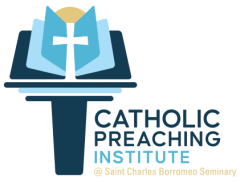
(St. Charles Borromeo Seminary)
The Catholic Preaching Institute (CPI) at St. Charles Borromeo Seminary will begin to take in reader responses on a unique online offering to help grow parishioner engagement in each Sunday’s Liturgy of the Word.
The “Hearing the Word” series has presented short commentaries on the Sunday Gospel reading, in newsletter format and on the seminary’s web site, each week for the past five months. In each edition of the newsletter a priest, deacon or expert in Scripture writes an explanatory article on the reading while a lay person pens a personal reflection on the Gospel’s significance for his or her life.
“‘The View from the Pew’ and ‘The View from the Pulpit’ offer a two-sided view of each week’s Gospel,” said Oblate Father Thomas Dailey, CPI project director and the John Cardinal Foley Chair of Homiletics and Social Communications at the seminary.
“A parishioner’s take on the meaningfulness of the Gospel story in their lives, and in life today, complements the explanation of the Gospel text given by the other writer.”
The series is aimed to help priests and deacons overcome what Father Dailey calls “the challenge of making their homilies applicable to the diverse people in the pews.”
CPI Managing Editor Laura Verdi explains that while the commentaries are meant to complement one other, they have different purposes.
“’From the Pulpit’ is an (explanatory) commentary to provide the reader with Gospel meaning,” Verdi said.
“We are working to have some writers better refine their writing so that they are scriptural commentaries regarding context, rather than ‘mini homilies’ that work in messaging about relevance, call to prayer, conversion of heart and spiritual growth.”
She admits that it is challenging for some clergy to undo the mindset of preparing a homily and instead stay focused specifically on interpretation of the Biblical text.
“’From the Pew’ provides a lay person’s perspective on how he or she relates to the Gospel, understands or doesn’t understand the Gospel, and how the Gospel is or isn’t meaningful,” Verdi adds. “Quite literally, how someone sitting in the pew thinks or feels after the priest (or) deacon reads the Gospel on Sunday.”
An example from Easter Sunday’s reflections showcases the differences between the texts.
“From the Pulpit,” was written that week by Kelly Anderson, S.S.L., Ph.D., associate professor of Biblical Studies for the seminary’s Theology Division. Anderson gives a view into what Mary Magdalene, St. Peter, and St. John each experience in discovering Jesus Christ’s empty tomb.
“Mary goes to the tomb while it is still dark, which in John’s Gospel indicates a state of unbelief. She finds the stone ‘removed,’ and the passive tense indicates that this is a divine action of God. But Mary remains in the dark, not even considering that a miraculous event has taken place,” Anderson said.
“The beloved disciple sees all of this, the stone rolled back, the empty tomb, the two cloths, and he has a flash of understanding, probably putting together all that the Lord had said and done, and he ‘saw and believed.’”
To contrast, Conor Donnelly from St. Saint Maron Maronite Catholic Parish in Philadelphia offers an experience of placing ourselves in that space, and how we experience that kind of moment in our own lives.
“That moment before light breaks — that’s where I often find myself when I think about death. Not just the abstract idea of it, but the real weight of having lost someone I love. I’ve stood at gravesides and felt the same bewilderment: Where are they now? Why does it feel so empty?” he wrote.
“And yet, Easter begins in that same kind of darkness. Without fanfare, something completely world-changing happens: Christ isn’t there. He’s alive.”
Father Dailey says that neither writer sees what their counterpart is offering for the week, so the reflections are independently written.
He adds that the entire series aims to respond to a research study CPI conducted in spring 2024.
“While CPI is certainly striving to help preachers be more compelling, an important factor in that is the listeners. After all, compelling preaching is not just what is said, but what is heard,” Father Dailey said.
“Specifically, the pastors in the archdiocese emphasized the need for preaching to be relevant to parishioners’ lives.”
So far, Father Dailey and Verdi both say direct feedback has been limited but positive, with one priest sharing that the “From the Pulpit” section has offered tools for his own homily preparation.
The next step begins the series’ official feedback process. “We will invite readers to offer comments and complete a brief survey,” Father Dailey said.
“Essentially, we’re looking for whatever reactions they may have in terms of both form and content, and we plan to take whatever recommendations they may have and revise (and) update the program accordingly.”
Readers of “Hearing the Word” can offer feedback by sending an email to CPI at preaching@scs.edu. Anyone interested in contributing commentaries can review program specifics by clicking here on the Writers’ Information Portal, then emailing Verdi at lverdi@scs.edu to begin participating.
PREVIOUS: Leaders in Media, Church Share How They Tell Stories of Hope
NEXT: Pope Appoints Bishop Mark Eckman as New Shepherd of Pittsburgh Diocese



Share this story